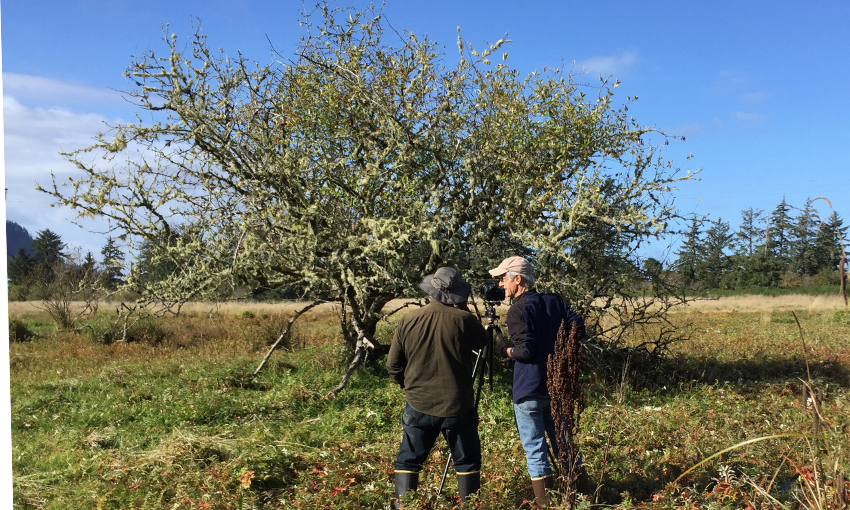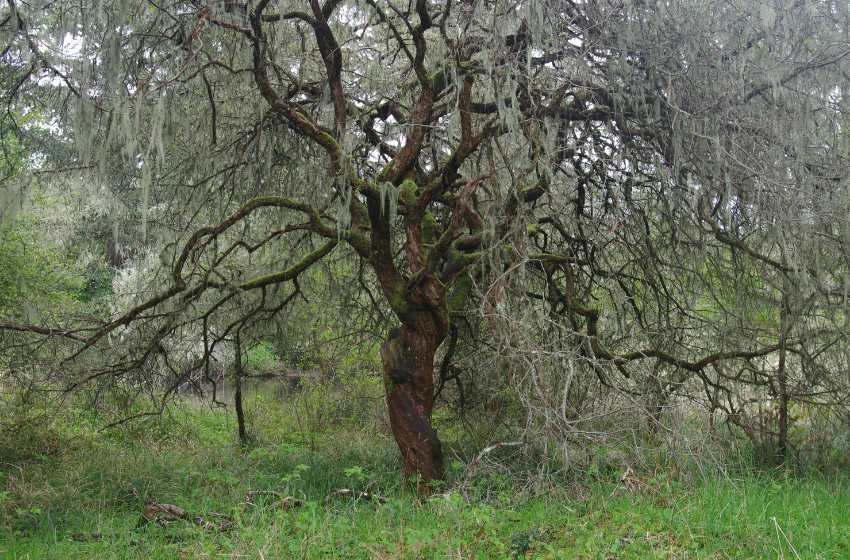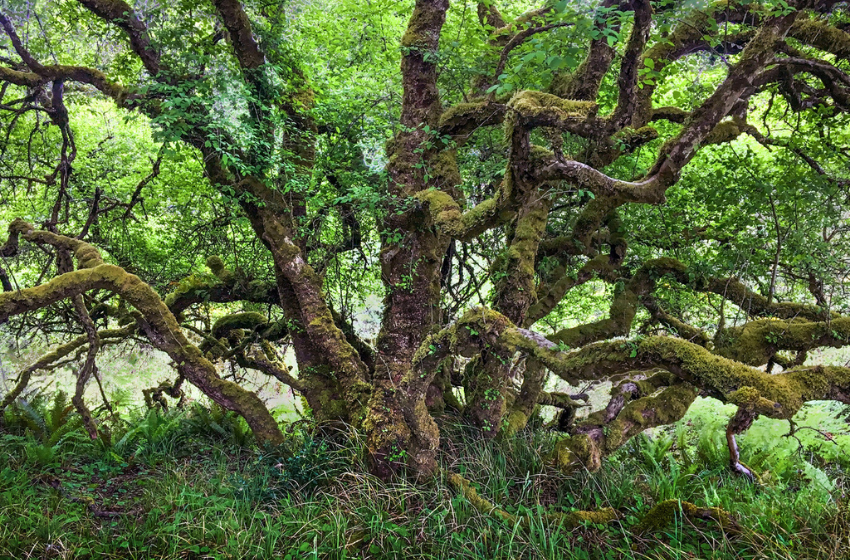 Back in early May of this year, at the height of our quarantine from nearly everything, I sat at my computer and wrote a small essay about some trees that had entered my life over the past few years. When I finished, I clicked “save” on my file menu and then waited for something, some inspiration that seemed to be missing. Then the summer came and went until I read Katie Voelke’s year-end letter to NCLC supporters, and the fog that sometimes hugs our coast began to clear. In the center of the letter Katie talked about a meditation using a tree. She asked us to “find a tree,” and then later “to anchor to a tree, your tree.” This is exactly what I had been doing.
Back in early May of this year, at the height of our quarantine from nearly everything, I sat at my computer and wrote a small essay about some trees that had entered my life over the past few years. When I finished, I clicked “save” on my file menu and then waited for something, some inspiration that seemed to be missing. Then the summer came and went until I read Katie Voelke’s year-end letter to NCLC supporters, and the fog that sometimes hugs our coast began to clear. In the center of the letter Katie talked about a meditation using a tree. She asked us to “find a tree,” and then later “to anchor to a tree, your tree.” This is exactly what I had been doing.
I was not alone. My friend Neal has a tree that he’s been visiting for more than sixty years, and more recently I’ve had my tree as well. And then there’s Katie with her western redcedar in the backyard. We’re in good company, from Siddhartha Gautama to Joyce Kilmer and John Steinbeck, who wrote in his Travels with Charlie of the California redwoods, “The feeling they produce is not transferrable. From them comes silence and awe.” This is certainly true of the magnificent redwoods, but I think you can find magic in even the most humble of trees.
—Jeff Roehm

Methuselah at king tide
A few weeks ago I was chatting back and forth online with my old friend Neal Maine when I sent him a photo. It was a picture of a scrubby little tree sitting out in the middle of a swamp. I’d been helping NCLC’s stewardship director, Melissa Reich, put together a conservation plan for a collection of five properties on Neawanna Creek, and we needed a photo for the cover page. I asked her if she had something in mind, and back came her totally expected response: “Methuselah in the king tide!” I thought I’d show it to Neal.
A little background: in fall 2017 Melissa put out a call to NCLC’s volunteer site stewards to see if anyone wanted to write about their experience on the land for NCLC’s “People+Plants+Wildlife” blog. I already had a story literally in my pocket, on my thumb drive. I held my breath and handed it to Melissa to see if it was what she wanted. The result was a tale of learning, love, and connection to the land that seemed to speak for many of our volunteers and staff; NCLC called it “Love letter to a tidal marsh.” At the center of the story was an ancient lichen-covered crabapple tree that I’d nicknamed Methuselah. To prepare for posting the story, Neal had met me out in Wahanna Marsh, the setting of the tale, and taken a photo. From there, with Neal’s photo and my story, this tree had become a mini-celebrity, featured in Katie Voelke’s 2017 end-of-year letter to supporters and then ending up in NCLC’s 2017 Annual Report. Later, in January 2018, I’d spotted my old friend Methuselah out in the marsh during one of our king tides. As an object d’art this photo wasn’t quite right—a little blown out by the afternoon sun. What made it cool was that in order to capture the moment, you’d have to wade out into the center of Wahanna Marsh in the middle of a king tide, something nobody would ever do.

Neal, Jeff, and Methuselah
I clicked “send” on my iMac, and almost by the speed of an electromagnetic wave came Neal’s response. “Thanks for sharing ‘your’ tree shot, love it. Big trees, conifers, get way too much attention, and it’s time the niche trees get some respect.” Well, Neal had certainly done his best to do that for the Pacific crabapple, and lately I’d gotten my chance too.
One of the first activities I remember doing with North Coast Land Conservancy was to take a little walk out into a habitat reserve they’d just recently acquired called Neacoxie Forest. Katie, who I think was still NCLC’s stewardship director at that time (and is now the executive director), was leading the walk. Neal was going to meet us out there. For some reason, Neal never materialized, but we had a great walk through the spruce, sedges, and skunk cabbage anyway. Later I was chatting with Neal in the office at Circle Creek about that walk, and he started talking about “that big old crabapple”—how it looked in the afternoon sun, and how he’d been trying to capture it in a photograph for years. I nodded, saying something like “Boy, that’s for sure, you bet,” while I thought to myself, “Crabapple?” I’d seen some big old crabapples there at Neacoxie Forest, but maybe I should have looked more closely.

‘Neal’s crabapple’ at Neacoxie Forest
Then later (and I mean a few years later) I was in Katie’s new office on the estuary and I saw a black-and-white photo of a super-interesting tree, all gnarled and contorted with age, what everyone now called Neal’s tree. Everything just fell into place in my mind, and I knew just what to do.
I don’t know if it was the process of locating that tree (I found it), or maybe a larger process of noticing things that up until this point had just been the white noise of growing up in Seaside. I’ve been out in Neacoxie Forest many times since then, planting violets, cutting holly, or just following along on a hike. I’ve always tried to take a little break and visit Neal’s tree for a little inspiration and take a few photos on the side. At the same time I began to notice crabapple trees as I walked out on my other native turf. Gradually I came to realize that this was a very special tree, native to the northern Oregon coast and very common on the edges of our marshes and coastal prairies—a tree that most people never notice.
Sometimes crabapple trees are tucked inside the forested wetlands that are so common around here, in among the mosses, sedges, and skunk cabbage and next to large, old Sitka spruces and alders. When you see them like that they’re covered with mosses and lichens with large, gnarled trunks that go this way and that, creating an eerie, ghostly effect. The canopy, with its leaves and fruit, is up there somewhere, out of the picture. How these big, old trees like Neal’s tree got in there is kind of a mystery, since they don’t really like shade very much. They start out as a sun-loving little bush back in the beginning days of the forest, and then watch as those taller trees grow up beside them and then above them. They are certainly very old—among the oldest trees in our forested wetlands.

But on the edges of the forest, or out in a marsh or meadow, where most crabapples are found, this tree species looks totally different. It’s a crazy, bushy little thing with its twiggy branches zigging and zagging, pointing this way and that. I’m reminded of the Pointless Forest from Harry Nilsson’s album The Point!, where all of the trees have points but they point in every direction, so “a point in every direction is really no point at all.” That’s our little tree for sure. And just for good measure, crabapple trees are armed. That’s right, they’ve got what are called spur shoots: sharp little things that stick out from the branches at ninety degrees to stick you in the earlobe or up your nose if you happen to wander off the trail.
I love this tree.
Then at the end of summer and on into October, our Pacific crabapple really shows us what it’s made of, literally. There’s nothing on the Oregon coast quite like the display of fruit that this little tree puts on. Because they ripen so late in the season and are so incredibly prolific, the Pacific crabapple is an important part of the coast ecology and the rhythm of nature. It’s that last blast of energy for migratory songbirds or for local critters heading into the long, wet winter.

Late in fall 2019 I was out at one of our sites on the Clatsop Plains, helping sow some native grasses with my Weed Warrior Wednesday pals. I’d long since decided that the crabapple was my tree, gnarled and crooked and sometimes kind of a pain. For some reason that day out on the open plain I found myself peeking inside a tiny grove of trees that nobody would ever notice. There before me was an old crabapple that was asking me to come on in and visit, which I did. This tree had eight or nine trunks spreading out from its center and was perhaps forty feet across its canopy, with the leaves high up above filtering the dappled light down to the forest floor. One of the things about trees that sets them apart is that a moment like this is almost impossible to photograph. But just being here and looking: anyone can do that.
Several months later, as things were beginning to wake up in early spring, I decided to attend Seaside’s first artwalk of the season. It was March 7, 2020, just before everything closed down. Neal as usual would be giving a short talk at Fairweather House and Gallery where his photography is always on display. This time he planned to talk about polar bears and to do a prize drawing for one of his fabulous photographs.
I was standing next to Neal, who was off to the side watching the proceedings and waiting for his turn to speak. He turned to me and said he’d been out at Neacoxie Forest earlier that day, “still trying to get a photograph of that tree.” Then he quipped, “I think I’m going to have to find another tree.” I pulled out my iPhone, scrolled down my photo app, and showed him: “Here’s one you can try.”

The Us Tree
“Where’s that?” Neal asked. I tried to explain, but Neal is from Gearhart and I’m not. So after some back-and-forth, I left it at “I’ll take you there.”
That’s how two days later, on a sunny morning in March, two old friends headed out across a grassy field on the Clatsop Plains. Neal had been there many, many times, compared to my quite-often, but today it just felt different. We walked into the tiny grove and just stood there. I think we were both wondering how we each could have been out here so many times and not seen this tree, at least not seen it like this.
We starting chatting about what was there before us, and we were clearly noticing different things. Neal was up close seeing lighting, angles, moss, and markings on the bark. For me it was the way the several trunks contorted, twisted, and turned out toward the canopy above. Neal was thinking about how things would appear later in the day when the sun was over our shoulders, or what would be the best season to photograph. But when you get down to the important part, Neal and I were having the same experience. This was an awesome tree.
I knew I had him. Neal would stay with it until he got that photograph that he wanted. This would not be easy, though. After all, it’s a tree.
Comments